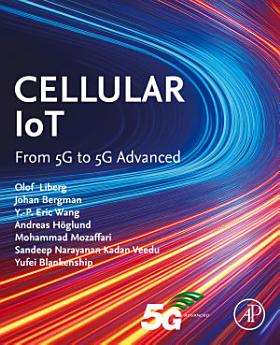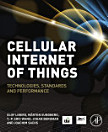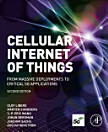Cellular IoT: From 5G to 5G Advanced
Olof Liberg · Johan Bergman · Y.-P. Eric Wang · Andreas Höglund · Mohammad Mozaffari · Sandeep Narayanan Kadan Veedu · Yufei Blankenship
Jun 2025 · Academic Press
Ebook
325
Pages
family_home
Eligible
info
reportRatings and reviews aren’t verified Learn More
About this ebook
Cellular IoT: From 5G to 5G Advanced gives an accessible and insightful explanation of 5G IoT technologies and standards. After an introduction to 5G and 5G Advanced, this book in detail goes through the 5G features that are vital for the support of IoT use cases. It describes how the 5G New Radio (NR) access technology has been adapted to provide cost- and energy-efficient connectivity for massive IoT and broadband IoT, as well as providing high data rates, ultra-reliability, and low latency to support immersive experience and time-critical communications. This book also discusses adaptations to support satellite communication, the future of massive IoT and how 3GPP is about to extend its support to near zero-energy and low-complexity devices and use cases. These forward-looking features will help evolve 5G and 5G Advanced toward realizing 6G visions such as a connected, sustainable, digitalized, and programmable physical world. - Explains how 5G NR is designed to support IoT - Shows the reasoning behind different design choices - Presents the 5G NR features that address different IoT use cases
About the author
Olof Liberg is a Line and Program Manager at Ericsson's department for Standards & Technologies. Olof joined Ericsson in 2008 and has specialized in the design and standardization of cellular radio access technologies. He is currently leading a team focused on radio and spectrum standardization and Ericsson's 3GPP radio access network standardization program. Olof holds a Bachelor's degree in Business and Economics and a Master's degree in Engineering Physics, both from Uppsala University. He has actively participated in the work of several standardization bodies, such as 3GPP, ITU-R, and ETSI. He was the Chairman of 3GPP TSG GERAN and its Working Group 1, during the 3GPP study on new radio-access technologies for the Internet of Things leading up to the specification of Narrowband IoT (NB-IoT). Olof is one of the authors behind the first and second edition of the book Cellular Internet of Things (Elsevier) and has coauthored several academic publications and contributed to more than 100 US patents.Johan Bergman is a Master Researcher at Ericsson Business Unit Networks. He received his Master of Science degree in Engineering Physics from the Chalmers University of Technology in Sweden. He joined Ericsson in 1997 to work with base station receiver algorithm design and performance, and since 2005, he has been working with 3G/4G/5G physical layer standardization in 3GPP TSG RAN Working Group 1. As the Rapporteur of the 3GPP TSG RAN Work Items for LTE for Machine-Type Communication (LTE-MTC) in Releases 13 through 16 and for NR RedCap in Releases 17 and 18, he has led the technical work to standardize new features dedicated to IoT. He was a corecipient of Ericsson's Inventor of the Year award for 2017.Y.-P. EricWang is a Research Leader at Ericsson Research. He holds a PhD degree in Electrical Engineering from the University of Michigan, Ann Arbor. In 2001 and 2002, he was a member of the Executive Committee of the IEEE Vehicular Technology Society and served as the society's Secretary. Dr.Wang was an Associate Editor of the IEEE Transactions on Vehicular Technology from 2003 to 2007. He has been a Technical Coordinator at Ericsson Research in the area of Internet of Things (IoT) connectivity. Dr. Wang was a corecipient of Ericsson's Inventor of the Year award in 2006. He has contributed to more than 200 US patents and more than 50 IEEE articles.Andreas Höglund has a Master of Science in Engineering Physics (2002) and a PhD in Condensed Matter Physics from Uppsala University (2007). He is a Principal Researcher at Ericsson Research and has, since he joined in 2008, worked on the L2/L3 of cellular networks (High Speed Packet Access (HSPA), LTE, New Radio (NR), system simulations, EU research projects, etc.). After the standardization of 3GPP LTE-MTC (Cat-M1) and NB-IoT in 2015, and the later evolution thereof, he has come to focus on cellular IoT networks. His recent work includes 3GPP standardization of Rel-17 RedCap and small data transmission (SDT), Rel-18 and Rel-19 eRedCap, small data transmission, wakeup receiver (WUR), Ambient IoT, and IoT research for 6G. He has contributed to more than 30 academic papers and over 100 US patents.
Rate this ebook
Tell us what you think.
Reading information
Smartphones and tablets
Install the Google Play Books app for Android and iPad/iPhone. It syncs automatically with your account and allows you to read online or offline wherever you are.
Laptops and computers
You can listen to audiobooks purchased on Google Play using your computer's web browser.
eReaders and other devices
To read on e-ink devices like Kobo eReaders, you'll need to download a file and transfer it to your device. Follow the detailed Help Center instructions to transfer the files to supported eReaders.





